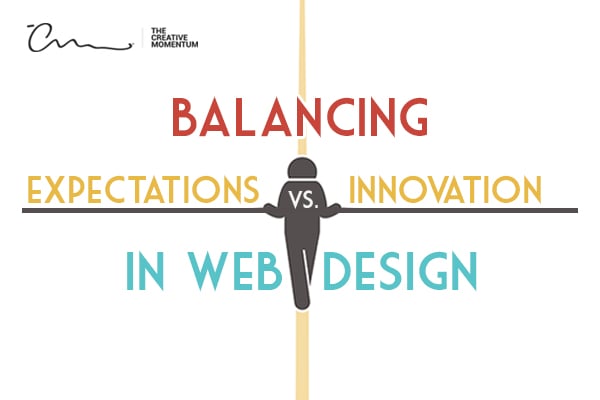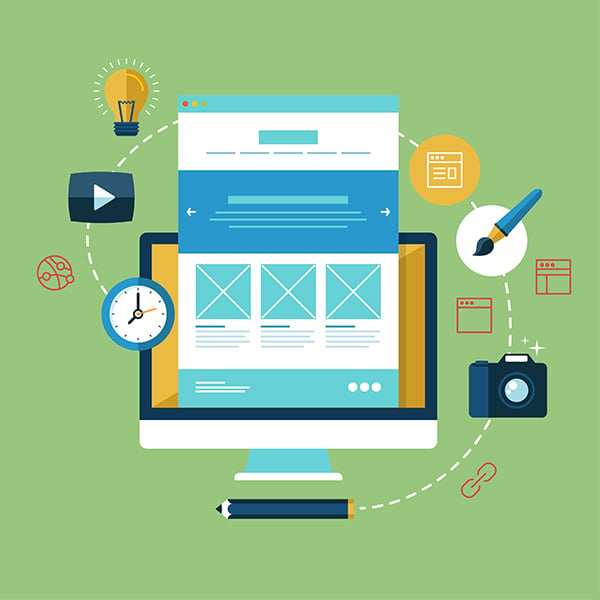
Whether you’re about to update an existing website or create one for the first time, there can be a battle of wills between expectations and reality.
Maybe your marketing team has decided that an innovative new web design, complete with eye-catching graphics and design elements, is what your company needs. Or, your web design team might lobby for proven UI and UX principles and demand that function is more important than style.
So, how do you find a balance that creates something exciting yet functional without getting lost in the weeds?
Prioritize Your Audience
First and foremost, no matter what the innovation in web design, keep your audience central during every stage in the design process. Making the marketing team happy, at the expense of your customers, will ultimately hurt revenue goals. Even if you're in love with a show-stopping, captivating design concept, it's best to focus on aspects that will move the sales needle.
Have you received customer feedback complaining about slow load times or forms that are glitchy? If so, that's where you need to focus your website improvements. A “beautiful” website with less-than-optimal functionality is, in reality, a pretty website that has high bounce rates and poor conversions.
If you’re not sure how to obtain customer feedback, consider encouraging customers to leave feedback either through your website or with a direct email campaign. This will help you create a targeted list of action items to incorporate into your web design strategy. Likewise, it’ll take the guesswork out of your efforts and ensure that you’re putting time and money into actions that will improve UX and build rapport.
Appeal to Customer Intent
According to Google, there are four key reasons a customer will visit your website: I-want-to-know, I-want-to-go, I-want-to-do, and I-want-to-buy. These are very divergent catalysts, and it can feel like a tall order to build a website that appeals to all of them.
But if you already have a good understanding of what motivates your audience to come to your website, then you have customer personas in hand and have mastered half the battle. Keep what motivates your audience central to your design goals.
If you're at a loss as to what drives your audience, one innovation in web design that may suite you is the captivating questionnaire — also known as the onboarding questionnaire.
While the idea of a questionnaire might seem like you’re creating a barrier to entry that might deter audiences, the opposite is actually happening.
Based on the products or services on your website, you create an easy questionnaire that’s relatable to your offerings. As the user works through the questionnaire (which should still only be a few slides and not an endless survey), the result sends them to the product or service recommendation that most closely aligns with the answers they provided.
Don't Compromise Usability for Innovative Design
Unless your website was already known for being avant-garde and edgy, or your audience is seeking the unexpected, now is not the time to make visitors guess at how to navigate from page to page or how to contact you. Again, doing this can encourage page abandonment. And when we say “don’t reinvent the wheel,” this includes:
- UI that is counter-intuitive and doesn’t follow useful conventions
- Questionable icons or labels that leave users lost on a page
- Content that isn’t properly formatted or features fonts and colors that are hard to read.
However, this doesn’t mean that you can’t add a few innovative touches to give your website some vitality. This can include options like scrolling transformations. Scrolling transformations are another innovation in web design where, as a user scrolls down the page, rather than a static page shifting upward, some elements move independently as they appear.
In some cases this can be highly interactive with every movement that a user makes with their fingers or mouse across a screen. But in other scenarios, it can simply be activated as the page is scrolling.
An added benefit of integrating scrolling transformations is that it can give the appearance of a modern and design-forward website, which is ideal if you’re concerned about overloading your website with design elements.

Create Content and the Design Simultaneously
A pretty website is nice, but poorly crafted content can send visitors running to a different site. Unless you’re in the business of visuals, you’ll want to ensure that your written or multimedia content is cohesive and complements the overall design.
Your content should clearly outline your business’s unique selling propositions (USPs), position you as an authority, and make it clear why visitors should contact you and not a competitor. If your content isn't tackling the "five W’s and How,” it isn't doing much for your business.
Along those lines, follow proven UI guides for written copy:
- Avoid walls of text
- Use subheadings to make content scannable
- Keep your audience in mind and avoid jargon
- Pick fonts that are legible and load consistently across devices
And Speaking of Loading . . .
We can’t say it enough. Website infrastructure matters. Aspects such as load time for pages and elements within a page, as well as whether you’ve integrated structural aspects like alt descriptions, metadata, and more, will impact your overall marketing strategy and ability to rank higher in search.
Google’s latest algorithm, Page Experience, puts weighted importance on how quickly your website loads and whether it has security features like HTTPS. But failing to incorporate features such as descriptions for images, or even proper metadata, can reduce how easily search engines can find your content.
And don’t forget that over a quarter of all American adults struggle with a disability. So, not offering image descriptions can make it difficult for someone with a visual disability to fully understand your message.
The takeaway is if your website's innovative design isn't properly supported with a solid website infrastructure, then all of the effort may be for naught.
Test Run Your Design
A common mistake is to not conduct a test run before launching a new site. It’s not enough to ask your design team to review the website. They—and you—are too close to the project to spot issues that a fresh pair of eyes could find glaring. Along with asking other colleagues who aren’t part of the process to test your site, consider asking an outside audience to test it.
Avoid Tinkering with Pages that Convert
A website redesign can be a great opportunity to improve website performance and unveil a fresh face to your target audience. However be mindful of what you’re tinkering with once you start playing under the hood. If you have key pages that perform well, you should be careful about overhauling them.
If you have pages with high traffic and high conversions, or low traffic but high conversions, it’s a sign that what you’re doing is working, and you should proceed with caution.
Conversely, pages that perform poorly or are below industry averages are ripe for updating. This includes both pages with low traffic and conversions as well as those that have high traffic but low conversions.
 Aim for a Pretty and Effective Design
Aim for a Pretty and Effective Design
The creation of a new website or redesigning an old website is a great opportunity to analyze whether you’re making an effective connection with your target audience. Be sure that your customers or target potential customers should be at the center of every decision. And if your end goal is to create a website that converts, you must keep them top of mind throughout the process.
Whether you need help gathering audience feedback or help turning those concerns into actionable change, The Creative Momentum can help. We have vast experience designing websites that are both impressive and that convert your audience.



